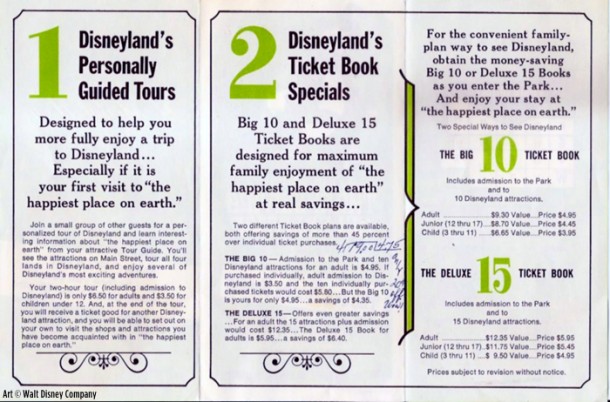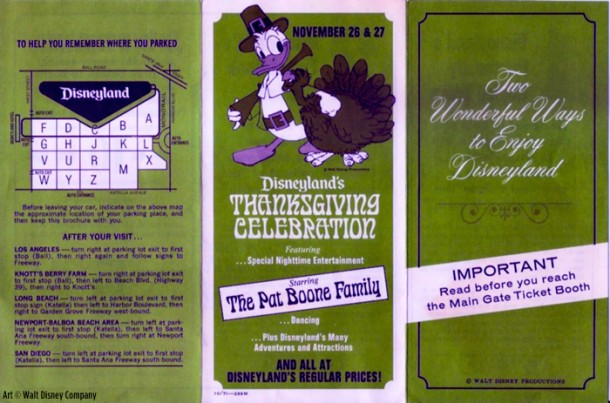Looking through my files the other day, I came across an early 1970s Cast Member training manual for Disneyland’s Main Street U.S.A. In this case, Main Street was describe as the area that included the parking lot, the Main Gate Ticket Sellers, the Ticket Takers, Guest Relations, Main Street vehicles, the shops, and other related activities. Since most of these Cast Members would be the source of “initial” contact with the guests, making a good first impression is their primary responsibility.
This attitude started at the parking lot. There were two entrances. The one at Harbor Boulevard had six entry lanes and the Katella Boulevard entrance had five. There were 11,500 parking spaces inside the 110-acre lot and it costs 50 cents to park. On an extremely busy day, more than 18,000 cars would make their way in and out of the lot. When you were ready to leave, there were three exits including one on West Street.
The ticket sellers would be the next contact. To enjoy the attractions, guests needed to purchase tickets. Three-fourths of the guests would buy a Ticket Book. From the Park’s operational standpoint there were a number of reasons why this was good for Disney. The Ticket Book was easy to market because it provided the guest a good value. Tickets helped to distribute the guests throughout the park and better utilize the Park’s capacity.

The real pressure was on the Ticket-Takers who made sure “that each guest be greeted warmly and as much as reasonably possible, be placed in a congenial frame of mind.” Whether the guest was entering one of the 16 entrance turnstiles or leaving through one of the nineteen exit turnstiles the host or hostess must send every guests, “either in or out, with a warm, friendly feeling and a desire to return.”
Cast Member learn that the Main Street vehicles were an integral part of the show. Their first function is to help set the mood by taking guests back to “Main Street U.S.A., circa 1900” where they notice the “contrast to the hustle and bustle of our modern world and its streamlined modes of transportation is sharp and penetrating.” Secondly, they served as a real transportation alternative, especially at the end of a long day. Finally, they provide an opportunity for Cast Members to interact with the guests, answering questions and giving tips. They called these operators as the “first impression–last impression” group.
Just like today, there were four ways to make your way up and down Main Street; the Horse-Drawn Street Cars, the Horseless Carriage, the Omnibus, or the Fire Engine.
The four Horse-Drawn Street Cars were composites of 19th Century street cars based on photographs of earlier vehicles. They were built at the Disney Studio Coach Shop. The horses that pull the Street Cars were called “our necessary secondary motor.” The horses are Percheron, Belgian, Clydesdale or a cross between Shire and Percheron. During training, the horses are subjected to conditions similar to what they may encounter in the Park. For a minimum of thirty hours, four hours a day, the horses are marched around a circular ring while loudspeakers blast music, horns, and the shouts of crowds. Once they pass, a handmade custom harness is crafted and they work a four-hour day, five-days a week. At the beginning and end of their shift they are given “taxi service” back to the Pony Ranch behind the Park where they clock in and out.
The Horseless Carriages were known as “1903’s” although “you could pick any year — 1904, ’05, or ’06, and be just as accurate.” The two-cylinder engines “have the horsepower, the sound — and even a slight case of the shakes — as did the originals.” Many guests prefer one of the two Omnibuses. Described as “close to authentic reproductions of Fifth Avenue buses” from turn-of-the-century New York.” The Park was proud to boast that the motors “have been converted to natural gas consumption and takes advantage of modern improvement which provide for better operation and no smog.”
There was also a motorized Fire Engine. The design was a composite of hose-carrying fire trucks of the turn-of-the-last-century with the guests taking the place of the hoses. Underneath the sheet metal was a modern (1950s) truck with a Jeep rear axle, a three-speed truck transmission, a pick-up truck engine, and standard drive-line parts. At least the bell is authentic “after considerable searching.”
A walk along Main Street in the early 1970s would feel both familiar and a bit strange. Let’s start with what is still here today. Of course, the Disneyland Emporium is in the same spot since opening day. The same for the Fire Department and Walt Disney’s Apartment. The two merchandise stands right at the tunnels, and the restrooms are still right where they have been. The Magic Shop, the Candy Palace, the Plaza Inn, and the Coca-Cola Refreshment Corner, are still where they have been for many years. The only change to the Mad Hatter Shop and the Silhouette Studio is they are no longer managed by lessees.
Some shows and shops have seen significant changes over the past 40 years. Once upon a time, the Main Street Cinema showed a variety of silent films instead of Mickey Mouse. After all, Mickey Mouse was not a silent film artist. He didn’t fit in the time frame of Main Street. Great Moments with Mr. Lincoln is in the Opera House with a show similar today to the one back then. Most of the merchandise has changed at the Market House. Fortunately, the pot-bellied stove, the party line phones, the Cider and dill pickles are still there. With the pin-ball machines removed, the Penny Arcade is no longer what it used to be.
There are many shops that have gone off to Yesterland. The Bank of America used to be the only bank in the United States that was open on Saturdays, Sundays, and Holidays. Now it is the Disney Gallery. There was the Wonderland Music Store was where you could find music boxes, player-piano rolls, and a complete selection of Disneyland and Buena Vista records.
Facing Town Square, in a space that is no longer used for anything was the Hills Brothers Coffee House & Restaurant. Nearby was a tribute to Walt Disney with a display for Cal Arts, a six-minute film about the school, and the 208 awards that Walt had received over his lifetime. Also facing Town Square was the Global Van Lines Parcel Storage Center. That space became part of the Emporium many years later. The Carefree Corner is also gone. Here, guests could sign the Official Guest Registration book. The Hallmark Communication Center was managed by Hallmark because they featured a complete display of greeting cards and the displays changed frequently.
Other shops missing today include the Tobacconist, where you could pick up a rare pipe or a special blend of tobacco, the Jewelry Store, the GAF Camera Center, and the Pharmacy. On one branch of Center Street was the outdoor Disneyland Art Festival. On the other branch was the Disneyland Flower Market where guests could purchase “many flower varieties, hand made for life-like appearance.” No longer could you get fresh squeezed orange juice from the Sunkist Citrus House or take a walk through Alpine Gardens or eat on the patio of the Plaza Pavilion restaurant-cafeteria or dance…sigh…at the Carnation Plaza Gardens.
Amazing what can happen in 40 years, isn’t it folks?
If you enjoy reading SAMLAND, you’ll love my book. Walt and the Promise of Progress City is a detailed look into how Walt Disney envisioned the future of communities. Along the way, we explore many facets of a fascinating man. Plus, buying the book helps ensure that I’ll be able to continue bringing you more Samland. It’s a win/win situation.








You must be logged in to post a comment.